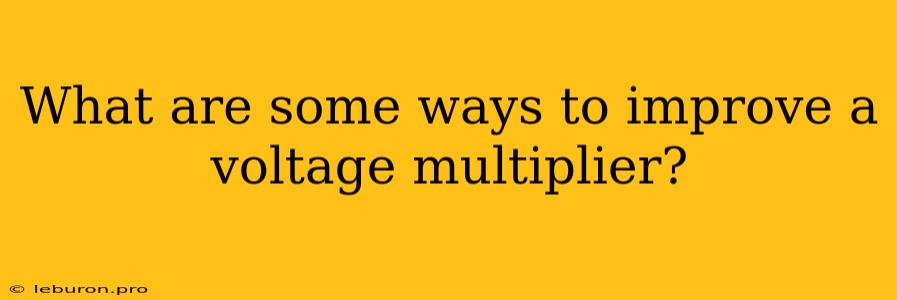Voltage multipliers are essential components in various electronic circuits, enabling the conversion of low-voltage AC or DC power into higher voltage outputs. While these circuits are highly efficient in their ability to boost voltage, there are several ways to improve their performance and ensure optimal operation. This article will explore key methods for enhancing voltage multiplier efficiency, addressing common issues, and maximizing output voltage stability.
Understanding Voltage Multiplier Fundamentals
Before delving into improvement techniques, it's crucial to grasp the fundamental operation of voltage multipliers. These circuits typically consist of diodes and capacitors arranged in a specific configuration to accumulate and amplify the input voltage. The most common type is the voltage doubler, employing two diodes and two capacitors to generate twice the input voltage. However, more complex configurations like triplers, quadruplers, and even higher multipliers exist, each adding additional diode-capacitor stages for greater output voltage.
Key Factors Affecting Voltage Multiplier Performance
Several factors can significantly impact the performance of a voltage multiplier:
- Input Voltage: The input voltage directly determines the output voltage. Higher input voltages result in proportionally higher output voltages.
- Load Resistance: The resistance of the load connected to the output affects the current drawn from the multiplier. Lower resistances draw higher currents, which can lead to voltage drops and reduced efficiency.
- Capacitor Values: Capacitor size plays a vital role in determining the voltage ripple and output current capacity. Larger capacitors provide better filtering and higher output current capabilities.
- Diode Characteristics: The forward voltage drop and reverse breakdown voltage of the diodes influence the overall voltage output and reliability.
- Operating Frequency: The frequency of the input signal affects the charging and discharging rate of the capacitors. Higher frequencies generally improve ripple reduction.
Strategies for Enhancing Voltage Multiplier Performance
1. Capacitor Selection
- Capacitor Size: Choose capacitors with sufficient capacitance to minimize voltage ripple and ensure adequate current delivery to the load. Larger capacitors provide smoother output voltage and improved current handling capabilities.
- Capacitor Type: Electrolytic capacitors are commonly used due to their high capacitance values, but they have limitations in high-frequency applications. Ceramic capacitors are more suitable for higher frequencies and can handle voltage surges better.
2. Diode Selection
- Forward Voltage Drop: Select diodes with low forward voltage drop to minimize voltage loss across the diodes. This translates to a higher output voltage and improved efficiency.
- Reverse Breakdown Voltage: The diodes should have a reverse breakdown voltage higher than the maximum expected output voltage to prevent premature failure.
3. Input Voltage Filtering
- Input Capacitors: Incorporating a large capacitor at the input of the voltage multiplier helps smooth out the input voltage, reducing ripple and improving overall performance.
- Inductor Filtering: In some applications, adding an inductor in series with the input can effectively suppress high-frequency noise and reduce ripple on the input signal.
4. Output Voltage Filtering
- Capacitors: Using a large capacitor at the output provides further filtering, minimizing voltage ripple and creating a smoother DC output.
- LC Filters: Combining an inductor and a capacitor in series can provide effective filtering, especially for high-frequency ripple.
5. Voltage Regulation
- Linear Regulators: Linear regulators can be used after the voltage multiplier to provide a stable and regulated output voltage, regardless of input voltage fluctuations.
- Switching Regulators: Switching regulators offer higher efficiency than linear regulators and are particularly useful for applications requiring regulated output voltage at high power levels.
6. Optimizing for Specific Applications
- High-Frequency Applications: When dealing with high-frequency input signals, select diodes and capacitors with low capacitance and low inductance to minimize energy losses and improve efficiency.
- Low-Voltage Applications: For low-voltage applications, consider using Schottky diodes, which have a lower forward voltage drop compared to conventional diodes.
Addressing Common Issues
- Voltage Ripple: Ripple in the output voltage can be caused by inadequate capacitance, low input voltage filtering, or high load currents. Addressing these factors through appropriate capacitor selection and input filtering can significantly reduce ripple.
- Efficiency: Lower efficiency can result from high diode forward voltage drop, high capacitance values, and high load currents. Optimizing diode selection, capacitor sizing, and load current control are key strategies for maximizing efficiency.
- Stability: Instability in the output voltage can arise from input voltage fluctuations, load changes, or parasitic capacitances. Implementing voltage regulation, proper load matching, and minimizing parasitic elements can help stabilize the output voltage.
Conclusion
Voltage multipliers offer efficient and reliable means of boosting voltage in various electronic applications. However, understanding the key factors influencing their performance is essential for optimizing their operation. By carefully selecting capacitors, diodes, and applying appropriate filtering techniques, along with employing voltage regulation if necessary, the efficiency, stability, and output quality of voltage multipliers can be significantly improved, ensuring optimal performance in diverse electronic circuits.
